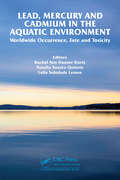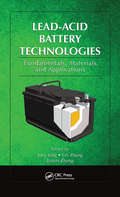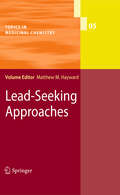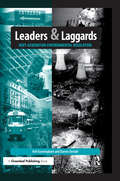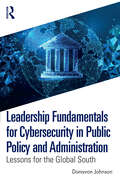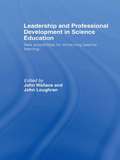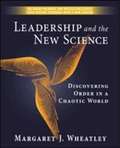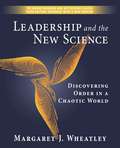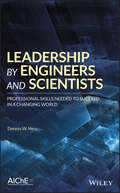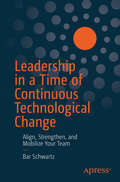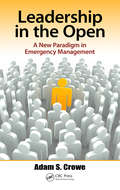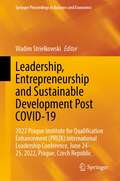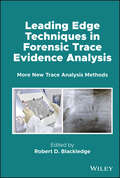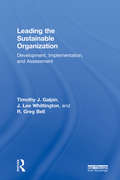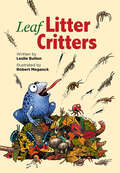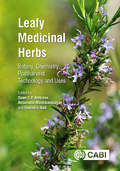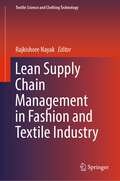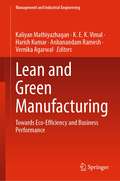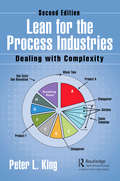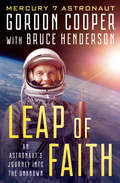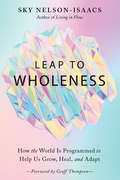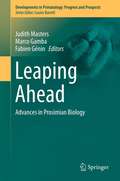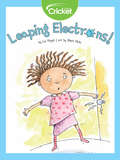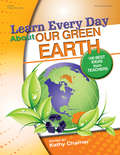- Table View
- List View
Lead, Mercury and Cadmium in the Aquatic Environment: Worldwide Occurrence, Fate and Toxicity
by Rachel Ann Hauser-Davis Natalia Soares Quinete Leila Soledade LemosThis book presents an integrated and holistic discussion on cadmium, lead and mercury toxicity in aquatic environments, expanding general concepts on chemical speciation effects and exploring specific environmental toxicological issues, exposure routes, and bioanalytical approaches for their determination and assessments on their intracellular deleterious effects. It contains worldwide and regional aspects on cadmium, lead and mercury occurrence, fate, and toxicity, addressing key environmental exposure and health risk concerns to both humans and aquatic organisms. Our book is of interest to anyone conducting research in the broad fields of oceanography, geochemistry, ecotoxicology, and environmental and public health.
Lead-Acid Battery Technologies: Fundamentals, Materials, and Applications (Electrochemical Energy Storage and Conversion)
by Lei Zhang Jiujun Zhang Joey JungLead-Acid Battery Technologies: Fundamentals, Materials, and Applications offers a systematic and state-of-the-art overview of the materials, system design, and related issues for the development of lead-acid rechargeable battery technologies. Featuring contributions from leading scientists and engineers in industry and academia, this book:Describe
Lead-Seeking Approaches
by Matthew M. HaywardChristopher A. Lipinski: Overview of hit to lead: the medicinal chemistâ__s role from HTS retest to lead optimization hand offJeff W. Paslay â_¢ John E. Morin â_¢ Richard K. Harrison: High Throughput Screening in the 21st CenturyJack Andrew Bikker â_¢ Lakshmi S. Narasimhan: Lead Discovery Using Virtual Screening Maurizio Pellecchia: NMR Spectroscopy in Fragment Based Drug DesignKevin D. Freeman-Cook â_¢ Daniel W. Kung: Hit Triage â__ Medicinal Chemistry Strategies to Improve the Odds of Success in DiscoveryJohn W. Ellingboe â_¢ Adam M. Gilbert: Lead Identification
Leaders and Laggards: Next-Generation Environmental Regulation
by Darren Sinclair Neil GunninghamConsensus is growing internationally that traditional command-and-control approaches to environmental regulation have borne much of their low-hanging fruit. Yet it is far from clear what should complement or replace them. Regulatory agencies and policy-makers are struggling with a lack of information about regulatory reform, about what works and what doesn't, and about how best to harness the resources of both government and non-government stakeholders. Progress is being impeded unnecessarily by a lack of shared knowledge of how similar agencies elsewhere are meeting similar challenges and by a lack of data on the success or otherwise of existing initiatives. Despite recent and valuable attempts to deal with such problems in the European Union and North America, these remain islands of wisdom in a sea of ignorance. For example, when it comes to dealing with small and medium-sized enterprises, very little is known, and what is known is not effectively distilled and disseminated. Much the same could be said about the roles of third parties, commercial and non-commercial, as surrogate regulators, and more broadly of many current initiatives to reconfigure the regulatory state. Based on the authors' work for the OECD, Victorian Environmental Protection Authority and the Western Australian Department of Environment Protection, Leaders and Laggards addresses these problems by identifying innovative regulatory best practice internationally in a number of specific contexts, evaluating empirically the effectiveness of regulatory reform and providing policy prescriptions that would better enable agencies to fulfil their regulatory missions. Focusing primarily on the differing requirements for both corporations and small and medium-sized enterprises in North America and Europe, the book aims to complement existing initiatives and to expand knowledge of regulatory reform by showing: how existing experience can best be put to practical use "on the ground"; by drawing lessons from experiments in innovative regulation internationally; by reporting and extrapolating on original case studies; and by advancing understanding on which instruments and strategies are likely to be of most value and why. The authors argue that the development of theory has outstripped its application. In essence, Leaders and Laggards aims to ground a myriad of theory on the reinvention of environmental regulation into practice. The book will be essential reading for environmental policy-makers, regulatory and other government officials responsible for policy design and implementation, academics and postgraduate students in environmental management, environmental law and environmental policy, and a more general readership within environmental policy and management studies. It will also be of interest to those in industry, such as environmental managers and corporate strategists, who are considering the use of more innovative environmental and regulatory strategies, and to environmental NGOs.
Leadership Fundamentals for Cybersecurity in Public Policy and Administration: Lessons for the Global South
by Donavon JohnsonIn an increasingly interconnected and digital world, this book provides comprehensive guidance on cybersecurity leadership specifically tailored to the context of public policy and administration in the Global South.Author Donavon Johnson examines a number of important themes, including the key cybersecurity threats and risks faced by public policy and administration, the role of leadership in addressing cybersecurity challenges and fostering a culture of cybersecurity, effective cybersecurity governance structures and policies, building cybersecurity capabilities and a skilled workforce, developing incident response and recovery mechanisms in the face of cyber threats, and addressing privacy and data protection concerns in public policy and administration. Showcasing case studies and best practices from successful cybersecurity leadership initiatives in the Global South, readers will gain a more refined understanding of the symbiotic relationship between cybersecurity and public policy, democracy, and governance. This book will be of keen interest to students of public administration and public policy, as well as those professionally involved in the provision of public technology around the globe.
Leadership and Professional Development in Science Education: New Possibilities for Enhancing Teacher Learning
by John Wallace John LoughranLeadership and Professional Development in Science Education provides invaluable insight into the role of science teachers as learners and thinkers of change processes. The fourteen chapters, by an eminent international team of science educators, explain and explore the relationship between professional development, teacher leadership and teacher learning. Research-based practical and theoretical exemplars reflect state of the art science teacher leadership in a broad range of international contexts.The book is divided into three parts, reflecting a multi-layered approach to teacher learning:* Personal initiatives in teacher learning, focusing on individual teachers;* Collegial initiatives in teacher learning, focusing on groups of teachers;* Systemic initiatives for teacher learning, focusing on system-wide issues.Student teachers and practising teachers will find the text highly valuable as they consider and review the challenges of teaching practice and ways of working with colleagues, while school leaders and policymakers will benefit from the book's insight into system-wide issues of professional development.
Leadership and the New Science
by Margaret J. WheatleyThe author believes that organizations of all sizes need to recognize that traditional, unbending organizational structures are not equipped to deal with today's chaotic world. The answer lies in the "new science" Quantum Physics.
Leadership and the New Science: Discovering Order in a Chaotic World
by Margaret J. WheatleyThe new edition of the bestselling, acclaimed, and influential guide to applying the new science to organizations and management. In this new edition, Margaret Wheatley describes how the new science radically alters our understanding of the world and how it can teach us to live and work well together in these chaotic times. We live in a time of chaos, rich in potential for new possibilities. A new world is being born. We need new ideas, new ways of seeing, and new relationships to help us now. New science—the new discoveries in biology, chaos theory, and quantum physics that are changing our understanding of how the world works—offers this guidance. It describes a world where chaos is natural, where order exists "for free." It displays the intricate webs of cooperation that connect us. It assures us that life seeks order, but uses messes to get there. This book will teach you how to move with greater certainty and easier grace into the new forms of organizations and communities that are taking shape. You'll learn that: • Relationships are what matters—even at the subatomic level• Life is a vast web of interconnections where cooperation and participation are required• Chaos and change are the only route to transformation In this expanded edition, Wheatley provides examples of how non-linear networks and self-organizing systems are flourishing in the modern world. In the midst of turbulence, Wheatley shows, we create work and lives rich in meaning.
Leadership by Engineers and Scientists: Professional Skills Needed to Succeed in a Changing World
by Dennis W. HessTeaches scientists and engineers leadership skills and problem solving to facilitate management of team members, faculty, and staff This textbook introduces readers to open-ended problems focused on interactions between technical and nontechnical colleagues, bosses, and subordinates. It does this through mini case studies that illustrate scenarios where simple, clear, or exact solutions are not evident. By offering examples of dilemmas in technical leadership along with selected analyses of possible ways to address or consider such issues, aspiring or current leaders are made aware of the types of problems they may encounter. This situational approach also allows the development of methodologies to address these issues as well as future variations or new issues that may arise. Leadership by Engineers and Scientists guides and facilitates approaches to solving leadership/people problems encountered by technically trained individuals. Students and practicing engineers will learn leadership by being asked to consider specific situations, debate how to deal with these issues, and then make decisions based on what they have learned. Readers will learn technical leadership fundamentals; ethics and professionalism; time management; building trust and credibility; risk taking; leadership through questions; creating a vision; team building and teamwork; running an effective meeting; conflict management and resolution; communication; and presenting difficult messages. Leadership by Engineers and Scientists is an excellent text for technically trained individuals who are considering, anticipating, or have recently been promoted to formal leadership positions in industry or academia.
Leadership in a Time of Continuous Technological Change: Align, Strengthen, and Mobilize Your Team
by Bar SchwartzDigital technology is rapidly challenging the way we do business, interact with our communities, and learn about the world. Due to this, leading change in your digital organization now comes with unprecedented tools and platforms to make your teams the most effective they can be. Leadership in a Time of Continuous Technological Change has arrived at this pivotal moment and is your roadmap for this exciting, evolving journey. Author Bar Schwartz introduces a holistic framework for leaders to take the reins in the digital Wild West. Achieving your team’s goals in this new environment will require high creativity, an entrepreneurial mindset, and a diversity of perspectives to solve problems that have never before been tackled. Roles and responsibilities have morphed, and what made you successful in the past may no longer apply. Leadership in a Time of Continuous Technological Change is an unmatched resource fit for our new decade. Through analyzing detailed case studies, you will see how understanding your identity paves the way to achieving emancipation, capability, and autonomy. Ultimately, you will be empowered to lead with clarity. Your team has everything they need to excel. Discover how alignment and clarity can support you in launching your team to new heights.What You Will LearnExamine case studies of different situations that can arise within a team and go through lists of takeaway questions that leaders can start asking to gain quick winsAdopt an agile mindset while taking into consideration the existing culture in the organizationCommunicate and align on expectations and goals with your team in a time of organizational change Who This Book Is ForEmerging leaders who are dealing with change or leading change and seek to increase the level of alignment and clarity for their people and themselves
Leadership in the Open: A New Paradigm in Emergency Management
by Adam CroweAs a relatively young field, emergency management has already undergone considerable evolution and change. And now that Web 2.0 technologies and social media sites such as Facebook and Twitter have become inherently ingrained in all facets of our lives, emergency managers must once again re-evaluate best practices and standardized approaches.Provid
Leadership, Entrepreneurship and Sustainable Development Post COVID-19: 2022 Prague Institute for Qualification Enhancement (PRIZK) International Leadership Conference, June 24-25, 2022, Prague, Czech Republic (Springer Proceedings in Business and Economics)
by Wadim StrielkowskiThe proceedings volume provides an account of the pandemic-inspired policy changes in leadership, entrepreneurship, and sustainable development. The volume is a collection of papers presented at the 2022 International Leadership Conference hosted by the Prague Institute for Qualification Enhancement (PRIZK), Czech Republic. The focus of the conference was to outline positive changes for leadership in business and economics based on the lessons learned during the pandemic. The enclosed selection of papers describe the digital surge in business, economics, and education, as well as the development of frontier technologies caused by the COVID-19 lockdown periods. They also provide new insights into the concepts of leadership, entrepreneurship, and sustainable development post the COVID-19 pandemic. Finally, the papers define the new place and role of leadership within the context of global initiatives in sustainability such as the European Union's Green Deal and the United Nations' Sustainable Development Goals (SGDs).
Leading Edge Techniques in Forensic Trace Evidence Analysis: More New Trace Analysis Methods
by Robert D BlackledgeLeading Edge Techniques in Forensic Trace Evidence Analysis In-depth exploration of the latest methodologies, tools, and techniques for analyzing trace evidence In Leading Edge Techniques in Forensic Trace Evidence Analysis, distinguished and highly qualified contributors cover the significant advances in methodology and instruments that are now being used to analyze trace evidence in forensic laboratories, including new techniques used to determine authenticity of objects and artifacts (such as Combined Raman/LIBS Microscopy) and those used to analyze surface treatments (such as py-GC-PARCI-MS). The work also covers new evidence types, such as surface-modified fibers, microscopic particles, and shimmer, and provides detailed explanations and practical examples of all of the aforementioned topics. Among the topics covered are: Forensic analysis of shimmer particles in cosmetics samples, glitter and other flake pigments, and x-ray photoelectron spectroscopy Surface acoustic wave nebulization mass spectrometry, forensic applications of gas chromatography vacuum ultraviolet, and spectroscopy paired with mass spectrometry Density determination and separation via magneto-Archimedes levitation and elemental imaging of forensic traces with macro and micro XRF Characterization of human head hairs via proteomics and Raman and surface-enriched Raman scattering (SERS) for trace analysis With detailed explanations of modern methodologies, tools, techniques, and evidence types in trace evidence forensics, along with helpful guidance to put covered concepts into practice, Leading Edge Techniques in Forensic Trace Evidence Analysis serves as an invaluable hands-on reference for scientists in forensic laboratories worldwide.
Leading the Sustainable Organization: Development, Implementation and Assessment
by J. Lee Whittington Tim Galpin Greg BellThis book is the first to combine the much talked about topics of leadership and sustainability, and provides readers with a comprehensive overview and pragmatic approach to leading sustainable organizations. Chapters include discussions, case examples, steps, and useful tools centred on the components of the Leading the Sustainable Organization model. This model provides managers with a pragmatic, end-to-end framework for creating (in the case of new entities) or shifting (in the case of existing firms) their organizations’ workforces to a sustainability focus. Leading the Sustainable Organization is the perfect tool for executives and managers in small, medium, and large companies, and in all industries, to assist with the difficult and confusing topic of leading sustainability efforts. This book will be of great interest to students and academics who want to learn more about corporate sustainability.
Leaf Litter Critters
by Leslie BulionTake a poetic tour through the duff and get the dirt on the tiny, fascinating critters that live there.For all the kids who can't resist turning over a rock, science poetry maven Leslie Bulion presents nineteen lively ecological poems in a variety of verse forms about the "brown food web" and the creatures that live there—from bacteria and rove beetles to mushrooms and millipedes, and all of the other busy recyclers in between. Illustrator Robert Meganck adds to the fun with humorous and vivid, yet scientifically detailed, artwork. Science notes run throughout for added context, and thorough back matter includes a glossary, poetry notes, hands-on investigations, and other resources for cross-curricular learning.
Leafy Medicinal Herbs: Botany, Chemistry, Postharvest Technology and Uses
by Dawn C.P. Ambrose Annamalai Manickavasagan Ravindra NaikMedicinal herbs are rich in vitamins, minerals and antioxidants, and are able to synthesize secondary metabolites with disease preventive properties. It is due to these qualities that herbs have been used throughout history for flavouring and in food, medicine and perfumery preparations. They are also often considered to be safe alternatives to modern medicines because of their healing properties. Though interest in medicinal and aromatic crops is growing worldwide, there is still little focus on the area of leafy medicinal herbs. This book compiles the literature for 23 globally relevant leafy medicinal herbs. Beginning with a general overview and discussion of the importance of these plants, it then handles each herb by chapter. Chapters discuss the botany of the crop, including its history and origin, geographical distribution and morphology, before focusing on the chemical composition and phytochemical attributes. They then review postharvest technology aspects such as processing and value addition, before concluding with the general and pharmacological uses for each crop. A complete compilation of the subject, this book forms a vital resource for researchers, students, farmers and industrialists in the area of leafy medicinal herbs.
Lean Supply Chain Management in Fashion and Textile Industry (Textile Science and Clothing Technology)
by Rajkishore NayakThis book highlights the concepts of lean manufacturing that help to achieve the objectives of sustainability in a global competitive atmosphere. Lean can help to lower the manufacturing cost in the rising labour and material cost market. Lean is based on various fundamental concepts such as Kaizen, Kanban, Zidoka, 5S and Six Sigma, which aim at reducing process waste for efficiency and productivity that are discussed in this book. In addition, the technological changes such as introduction of Internet technologies and Industry 4.0 are taken care by the lean concepts, which are also addressed in this book.
Lean and Green Manufacturing: Towards Eco-Efficiency and Business Performance (Management and Industrial Engineering)
by Harish Kumar Kaliyan Mathiyazhagan K. E. K. Vimal Anbanandam Ramesh Vernika AgarwalThis book provides a stage-by-stage integration of lean and green manufacturing paradigms to achieve environmental and economic benefits. The book includes chapters on conceptual development for incorporating the lean and green paradigm, and methods, tools and techniques for developing and integrating lean manufacturing. Several case studies which demonstrate the benefits of integrating lean and green manufacturing techniques are also covered here. The contents of this book are expected to support researchers and practitioners in the implementation of integrated lean and green manufacturing technologies.
Lean for the Process Industries: Dealing with Complexity, Second Edition
by Peter L. KingCompared to its widespread implementation across almost all areas of production, Lean improvement efforts lag within the process industries. While many innovators have successfully applied Lean principles to these industries during the past three decades, most of those pioneering efforts were never recorded to guide the improvement efforts of others. Drawing on more than 40 years of application experience at one of the world’s largest chemical and materials manufacturers, coupled with 10 years in private practice, Peter King corrects this void by providing the first comprehensive resource written explicitly for change agents within the process industries. Focusing on areas where the improvement needs of the process industry differ from parts assembly manufacturing, Lean for the Process Industries: Dealing with Complexity, Second Edition: Covers each of the eight wastes commonly described in Lean literature, looking at how they manifest themselves in process operations. Explains how to adapt value stream mapping for process operations. Shows how to identify the root causes of bottlenecks, and how to manage them to optimize flow until they can be eliminated. Provides practical techniques to overcome the barriers which have prevented the application of Cellular Manufacturing to process operations. Discusses the role of business leadership in a Lean strategy, describing both enabling and counter-productive management behaviors Since the publication of the first edition of this book, Peter King has been busy consulting with food, beverage, gasoline additive, and nutraceutical companies -- these new experiences have broadened his perspectives on certain Lean processes and have given him a richer set of examples to discuss in this new edition. While Value Stream Mapping is a very powerful tool to understand flow, bottlenecks, and waste in an operation, the traditional format as presented in many other books does not describe all of the data required to fully understand process flow and its detractors. This new edition highlights the necessary additions with examples of why they are useful. Product wheel scheduling achieves production leveling in a far more comprehensive and effective way than traditional heijunka methods. This edition has a more thorough description of the wheel concept and design steps, and more examples from actual applications.
Lean for the Process Industries: Dealing with Complexity, Second Edition
by Peter L. KingCompared to its widespread implementation across almost all areas of production, Lean improvement efforts lag within the process industries. While many innovators have successfully applied Lean principles to these industries during the past three decades, most of those pioneering efforts were never recorded to guide the improvement efforts of others.Drawing on more than 40 years of application experience at one of the world’s largest chemical and materials manufacturers, coupled with 10 years in private practice, Peter King corrects this void by providing the first comprehensive resource written explicitly for change agents within the process industries. Focusing on areas where the improvement needs of the process industry differ from parts assembly manufacturing, Lean for the Process Industries: Dealing with Complexity, Second Edition: Covers each of the eight wastes commonly described in Lean literature, looking at how they manifest themselves in process operations. Explains how to adapt value stream mapping for process operations. Shows how to identify the root causes of bottlenecks, and how to manage them to optimize flow until they can be eliminated. Provides practical techniques to overcome the barriers which have prevented the application of Cellular Manufacturing to process operations. Discusses the role of business leadership in a Lean strategy, describing both enabling and counter-productive management behaviors Since the publication of the first edition of this book, Peter King has been busy consulting with food, beverage, gasoline additive, and nutraceutical companies -- these new experiences have broadened his perspectives on certain Lean processes and have given him a richer set of examples to discuss in this new edition.While Value Stream Mapping is a very powerful tool to understand flow, bottlenecks, and waste in an operation, the traditional format as presented in many other books does not describe all of the data required to fully understand process flow and its detractors. This new edition highlights the necessary additions with examples of why they are useful.Product wheel scheduling achieves production leveling in a far more comprehensive and effective way than traditional heijunka methods. This edition has a more thorough description of the wheel concept and design steps, and more examples from actual applications.
Leap of Faith: An Astronaut's Journey Into the Unknown
by Bruce Henderson Gordon Cooper&“An exciting insider&’s look at Projects Mercury, Gemini and Apollo . . . NASA&’s internal politics, disasters, glitches and close calls&” by a pioneering astronaut (Publishers Weekly). Gordon &“Gordo&” Cooper was one of the original Mercury Seven astronauts, pilot for Apollo X, head of flight crew operations for the United States&’ first orbiting space station, and the last American to venture into space alone. Stretching from the dawning days of NASA to the far reaches of the unknown, Cooper&’s distinguished career as a record-setting astronaut helped shape America&’s space program and blazed a trail for generations to come. In this astonishing memoir—written with #1 New York Times bestseller Bruce Henderson—Cooper crosses paths with such aviation luminaries as Amelia Earhart, Wiley Post, and German rocket scientist Wernher von Braun; he shares his early days at Edwards Air Force Base and the endeavors that became the basis for The Right Stuff; he takes us inside NASA with candid accounts of his defeats and accomplishments; he reflects on the triumphs and tragedies of his heroic colleagues; and he finally reveals the reasons behind his belief in extraterrestrial intelligence, including the US military&’s long-standing UFO cover-ups. Buckle yourself in for a breathtaking ride because in Leap of Faith, Gordon Cooper takes readers to places they&’ve never been before.
Leap to Wholeness: How the World Is Programmed to Help Us Grow, Heal, and Adapt
by Sky Nelson-IsaacsAn investigation into the physics of light and our journey toward healing, connection, and wholeness.The reductionism and materialism of our modern world make it easy to imagine everything can be cleanly broken down into smaller and smaller parts. Yet the straightforward example of light in a hologram, which can't be reduced to its parts, points to an underlying interconnected reality--a wholeness. Physicist Sky Nelson-Isaacs uses numerous familiar examples--rainbows, music, photography--to illustrate a fundamental wholeness found in nature.Just as light is filtered as it passes through a filmstrip, Nelson-Isaacs points out that our human experience is filtered through thoughts and feelings. This view provides an explanation as to why, in our daily lived reality, we can feel so broken and not-whole. Nelson-Isaacs weaves together cutting-edge ideas into the nature of space and time and original research, with a compelling message of urgency. The filters we use to make choices everyday hide important information from us, leading us away from experiences of flow. Through synchronicities, we are led to life lessons tailored to our readiness for change. Nelson-Isaacs reconsiders the view of time itself, suggesting that we live not just in this moment but on a timeline of history, part of a wave moving from our past into our future. Every choice we make shifts what is available to us. Can we learn to rethink our lives and reality to remove our filters and realize the wholeness that we have inherent in ourselves and in our world? Yes, says Nelson-Isaacs--and once we do that, we can use the multiverse of possibilities to make choices that help us heal and grow into a greater sense of ourselves.
Leaping Ahead
by Fabien Génin Russell Tuttle Marco Gamba Judith MastersLeaping Ahead: Advances in Prosimian Biology presents a summary of the state of prosimian biology as we move into the second decade of the 21st century. The book covers a wide range of topics, from assessments of diversity and evolutionary scenarios, through ecophysiology, cognition, behavioral and sensory ecology, to the conservation and survival prospects of this extraordinary and diverse group of mammals. The collection was inspired by an international conference in Ithala, KwaZulu-Natal, South Africa in 2007, where prosimian biologists gathered from Canada, Finland, France, Germany, India, Italy, Japan, Madagascar, South Africa, Tanzania, the United Kingdom, and the United States of America. The meeting reverberated with the passion prosimian researchers feel for their study subjects and with their deep concern for the future of prosimians in the face of ongoing habitat destruction and the burgeoning threat of bushmeat hunting. Chapters for this volume were contributed by researchers from across the globe; they attest to the diversity, vibrancy and rapid growth of prosimian biology, and to the intellectual advances that have revolutionized this field in recent years. Since its earliest beginnings, prosimian research and its resultant literature have had a strong francophone component, and researchers in many prosimian habitat countries are more comfortable reading and writing in French rather than English. French summaries of all chapters have been included. The volume is targeted at researchers, both those entering the field and established scientists, who have an interest in the biology of primates and small mammals. It is also aimed at conservation biologists seeking a deeper understanding of the faunas and conservation developments in Africa, Madagascar and Southeast Asia, and anyone who has an interest in discovering the true diversity of our order, the Primates.
Leaping Electrons!
by Liz HuyckElectrons are extremely tiny charged particles that we can push around with magnets. This provides us with electricity.
Learn Every Day About Our Green Earth: 100 Best Ideas from Teachers
by Kathy CharnerLearning about OUR GREEN EARTH has never been so much fun! Taking care of our planet has never been more important, and this book will teach even the youngest children about environmental responsibility. Learn Every Day About Our Green Earth makes it easy for teachers to incorporate discussions about caring for the Earth into any curriculum with activities that promote responsible behaviors and are fun and enjoyable. In this book, activities like "Recycling Adds Up" and "Block Compost" teach children the importance of reusing and recycling, while "Thank a Tree" and "Worms Are Good Guys" teach them to respect and love nature. Global awareness is everyone's responsibility, and the activities in Learn Every Day About Our Green Earth help teachers pass along this important knowledge to the next generation.Each activity features: * Learning objectives * Vocabulary * Related children's books * Materials * Preparation (if necessary) * What to do * An assessment component Each of the books in the Learn Every Day series offers teachers 100 classroom-tested activities that make learning fun and engaging for young children!
